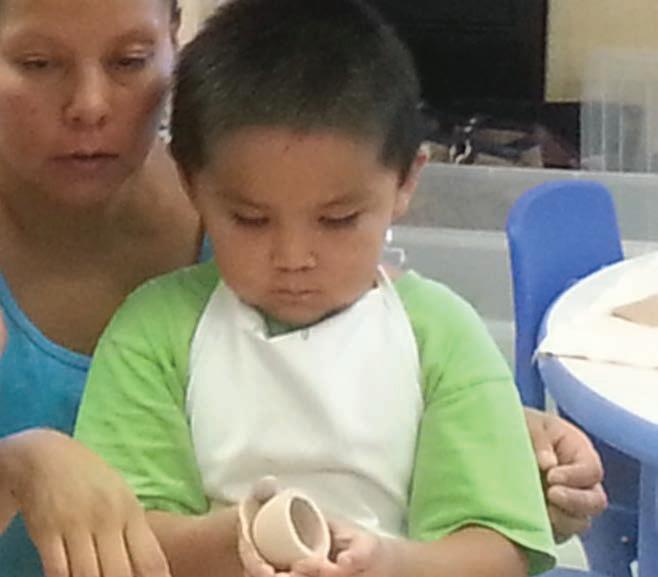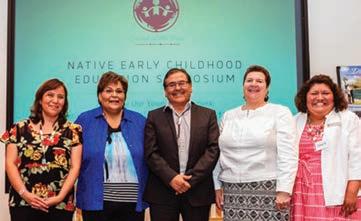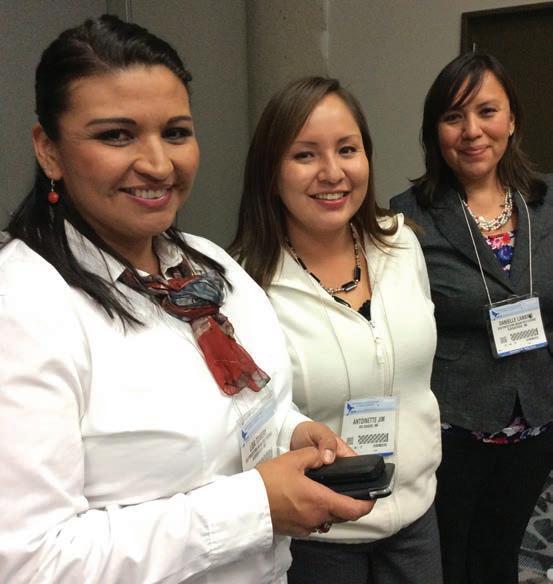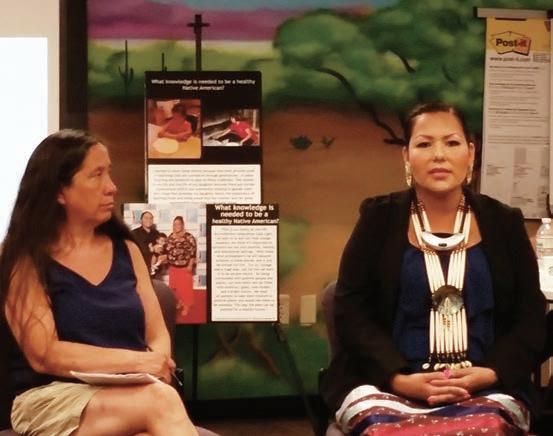
9 minute read
Impact of the TCU Early Childhood Education Initiative
We hope that when we invest in this process that families will always be at the table, and that they will draw the plans for that sustained effort of more families being at the table and changing the face of early childhood education.
— Tarajean Yazzie-Mintz, Vice President, Program Initiatives, American Indian College Fund
We have been a part of this program since Sacred Little Ones. I wanted to continue participation because I have always enjoyed the connectedness of the people in the program. I feel like this program has been reciprocal to our family, we learn and benefit and we also try to do our best to participate and volunteer during activities.
— Parent, Southwestern Indian Polytechnic Institute
The last time I did Special Time with my 2 year old daughter, she brought me a book. I started to read it, but she kept changing the pages, so I just read what parts I could in the quick split seconds she allowed me. She started pointing out things in the pictures. Then she said, “Mom, Mom. Look at me, Mom.” I knew she wanted me to see her — truly see her. It was as if it was a replacement for all the times I was at work, at school, doing homework, looking at my phone, or what-have-you. She wanted to look at me looking at her, knowing that I see her, knowing that I love her.
— Parent, Northwest Indian College
There are various ways of measuring and understanding the range and diversity of impact of the TCU Early Childhood Education Initiative. Two particular focal areas are program impact and research impact. In looking at impact, important questions are: In what ways has the initiative increased knowledge about early childhood education, and for whom was knowledge increased? What changes were made in programs, practices, approaches, and beliefs about early childhood education? In creating and strengthening systems of care and learning with Native communities from birth to career, we have focused on multiple levels of programming, which creates impact on several levels: Individual, Institutional, Community/Tribal, and Systemic. At the individual level, the impact is on children, TCU students, teachers, parents, and families. Through this initiative, children have access to learning about and through their culture, language, and history. An example of the initiative’s impact on children is at College
of Menominee Nation, where CMN students and faculty created children’s books in Menominee so children can learn literacy through their Native language and traditions. An example of the impact of the initiative on TCU students is at SIPI, where the focus has been on strengthening the teacher education program. Through emphasis on engaging with families in the early learning center to develop curriculum and activities, and through emphasis on nation-building, future teachers prepare for their roles as leaders in Native communities. The initiative impacts current teachers by providing professional development opportunities, including opportunities to develop skills, gain knowledge, and conduct and present research. At Salish Kootenai College, for example, teachers (including current teachers and preservice teachers) received training to integrate Special Olympics, Indigenous Games, and Salish and Kootenai languages. These teachers are now more prepared to work with families and children with special needs (as well as those without special needs), with new knowledge on health, wellness, language, and culture. As experts on their children’s strengths, parents and families are being empowered through this initiative as part of strengthening systems of care and learning to develop curriculum and analyze data. The Photovoice project at SIPI, in which families used photos they took of themselves and their children to share who they are as Native people, is one example of the way in which authentically engaging parents and families in curricular activities has an impact on the children, families, and teachers. At the institutional level, there is a profound impact on the tribal colleges and universities and the early learning centers, in particular. The TCUs – College of Menominee Nation, Southwestern Indian Polytechnic Institute, Northwest Indian College, and Iḷisaġvik College are strong examples — have stronger teacher education programs at this point than they did at the start of the initiative. Incorporating language and culture as key elements of courses, preparing teachers to be leaders in their communities, having preservice teachers work on family engagement, and partnering with early learning centers all create a pronounced and positive impact on teacher education programs at these institutions. These partnerships with early learning centers also benefit the early learning centers. There is a larger pool of knowledgeable educators to work with the children in the centers, and the preservice teachers are better prepared to work with early learners when they graduate. Further, institutionally, the TCUs gain tools and knowledge from the ECE community-based projects that they have applied to their own institutional work. For example, SIPI went through a successful accreditation process using knowledge gained from the community-based and collective inquiry processes employed in the ECE initiative. In addition, faculty at these TCUs have elevated the standing of their institutions through their presence at national and international conferences, through the research inquiry they have conducted and published, and through the new knowledge they have contributed to the field. Finally, TCU ECE Project Directors have taken on leadership roles in their institutions and on committees of national associations, contributing to their TCUs beyond early childhood education.

The impact at the community/tribal level is significant. At each of the seven TCUs directly involved in the ECE initiative, the home-to-school and school-to-home connection has been strengthened. In creating systems of care and learning in early childhood education, it is critical that parents and families are authentically and strategically engaged in the work of educating their children. Often in schooling environments, parents and families are brought in and expected to support the school’s pre-decided activities, curriculum, and assessments. This is frequently what passes for “engagement,” and leads to parents and families dis-engaging because of their lack of a genuine role in the work. By contrast, in this initiative, parents and families are viewed as knowledge experts on the strengths and challenges of their children, playing critical roles in the development of curriculum, analysis of data, and production of cultural events. The success of this approach is evident at each of the project sites. For example, at KBOCC, a team of veteran teachers who have been working in the field for decades are astounded at the number of parents and family members who attend Family Fun Nights. As Kim Swanson says, “I have worked in this field for 25 years. In my past experiences, we would have two families show up. At Little Eagles, we have 50 families for Family Fun Nights.” This is not an accidental occurrence. It is the result of creating a system of care and learning in which families, and by extension the community through the involvement of elders and knowledge-keepers, is an integral part of the system that creates a healthy, educational environment for the education of the community’s earliest learners. Finally, there is an important impact of this work at the systemic level. First, at the level of TCUs, there is great knowledge-sharing between and across the sites. One of the unique aspects of this initiative is that, guided by the Strategic Cycles of Educational Transformation and the Five Domains, each TCU approaches the work of educating their earliest learners from a launch point that is determined by the community’s culture, traditions, knowledge, and expertise. All sites are heading toward the same articulated goal; each will get there by a different path. These seven TCU sites have engaged with each other — at convenings, at conferences, in consultations, and as colleagues — to share experiences, learnings, and expertise. Each site brings different expertise and experience, and the cross-site collaborations are enormously productive. Second, the initiative and these TCUs have made national connections and collaborations, presenting at conferences, seeking professional development, and assisting with the development of other early childhood education programs. For example, the initiative has partnered for several years with the National Association for the Education of Young Children (NAEYC), hosting national forums, connecting with NAEYC’s Tribal and Indigenous Early Childhood Network (TIECN), and consulting with (and having an impact on) the accreditation of early childhood programs. Brazelton Touchpoints Center at Boston Children’s Hospital is a partner in training and

collaboration. Project sites have presented at the annual meeting of the American Educational Research Association (AERA), the premier international research organization in the US, sharing research conducted at TCUs in a forum regularly dominated by work from research-based institutions. In addition, site Project Directors have run for and been elected to offices in the Indigenous Peoples of the Americas Special Interest Group at AERA, bringing voices and perspectives from tribal colleges into the dialogue within the group of Native scholars at AERA. These are just a few of the national and international connections and collaborations with which this initiative has engaged. Third, the initiative and TCUs have made international connections as well, including presenting at the World Indigenous Peoples Conference on Education (WIPCE), and learning from and collaborating with international programs and Indigenous scholars. The impact that this initiative has had at the systemic level has reciprocally benefited the initiative and the TCUs as well, with the national, international, and cross-Indigenous connections fueling opportunities to grow our own teachers for our communities and strengthen early childhood education based on Indigenous theories and perspectives. In addition to the program impact, the initiative has had an impact on research in the field. Just as the TCU ECE initiative is built on an Indigenous approach to early childhood education with Native communities building their own early childhood programs, we take the same approach to research in Native early childhood education. Locally-driven inquiry, driven by the priorities of the community, is the most powerful, impactful, and effective research in early childhood education. Given that much research on Native communities is initiated and conducted from outside the communities, doing research for the sake of research — e.g., asking questions the researcher is interested in (rather than taking into account the needs of the community) — it is especially critical that this initiative develops inquiry from within communities. The College Fund has been protective of research on these projects and initiatives. A number of researchers have requested data from these projects, in order to analyze them and publish articles based on them. In keeping with the philosophy that the best education for our earliest learners comes from within the communities, the College Fund has maintained that the best research on early childhood programs comes from within the communities. Therefore, any research on these projects will be initiated and conducted from within the communities involved. As a result, in addition to evaluations conducted by external evaluators contracted by the College Fund, there have been, to date, at least seven research publications on the projects authored by individuals from within the communities served by these initiatives and tribal colleges. In addition, individuals involved with the initiative have given presentations at research conferences, symposia on the projects, keynote lectures, guest talks, and media interviews. Our purpose in this initiative is to program for impact, and document for learning and sustainability. Therefore, we will continue to document the impact of the programs, and continue to produce research from within the communities served by this initiative.










